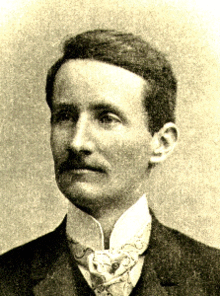Walther Ritz
| Walther Ritz | |
|---|---|
 | |
| Born |
February 22, 1878 Sion, Switzerland |
| Died |
7 July 1909 (aged 31) Göttingen |
Walther Ritz (b. February 22, 1878 in Sion, Switzerland - d. 7 July 1909 in Göttingen) was a Swiss theoretical physicist.
His father, Raphael Ritz, a native of Valais, was a well-known landscape and interior scenes artist. His mother was the daughter of the engineer Noerdlinger of Tübingen. Ritz studied in Zurich and Göttingen. He is most famous for his work with Johannes Rydberg on the Rydberg–Ritz combination principle. Ritz is also known for the variational method named after him, the Ritz method. Ritz died in 1909, at the age of 31. According to Forman's Dictionary of Scientific Biography, Ritz contracted tuberculosis in 1900, which led to his death in 1909. According to Ritz's collected works (Œuvres) the disease was pleurisy.
Criticism of Maxwell-Lorentz electromagnetic theory
Not so well known is the fact that in 1908 Walter Ritz produced a lengthy criticism of Maxwell-Lorentz electromagnetic theory, in which he contended that the theory's connection with the luminescent ether (see Lorentz ether theory) made it "essentially inappropriate to express the comprehensive laws for the propagation of electrodynamic actions."
Walter Ritz pointed out seven problems with Maxwell-Lorentz electromagnetic field equations:
- Electric and magnetic forces really express relations about space and time and should be replaced with non-instantaneous elementary actions (his emission theory).
- Advanced potentials don't exist (and their erroneous use led to the Rayleigh-Jeans ultraviolet catastrophe).
- Localization of energy in the ether is vague.
- It is impossible to reduce gravity to the same notions.
- The unacceptable inequality of action and reaction is brought about by the concept of absolute motion with respect to the ether.
- Apparent relativistic mass increase is amenable to a different interpretation.
- The use of absolute coordinates, if independent of all motions of matter, requires throwing away the time honored use of Galilean relativity and our notions of rigid ponderable bodies.
Instead he indicated that light is not propagated (in a medium) but is instead projected.
References
- Forman, P., Dictionary of Scientific Biography XI, 475, Charles Scribner's Sons, New York, 1975.
- Ritz, W., Annales Chemie et de Physique, 13, 145, (1908), page 172. See link to Critical Researches ..., below.
- Gesammelte Werke - Walther Ritz - OEuvres, Societe suisse de physique, Gauthier-Villars, Paris, 1911, page viii.
- Jean-Claude Pont (ed.) Le Destin Douloureux de Walther Ritz, physicien théoricien de génie, Sion: Archives de l'Etat de Valais, 2012 (= Proceedings of the International Conference in Honor of Walther Ritz's 100th Anniversary).
External links
- Abbreviated Biographical Sketch of Walter Ritz
- Critical Researches on General Electrodynamics, Walter Ritz, 1908, English translation
- Ritz, Einstein and the Emission Hypothesis
|